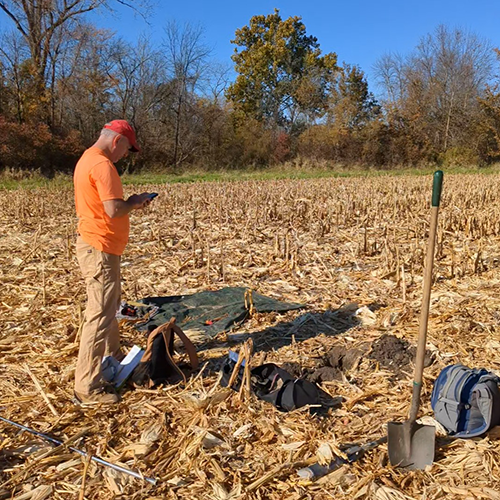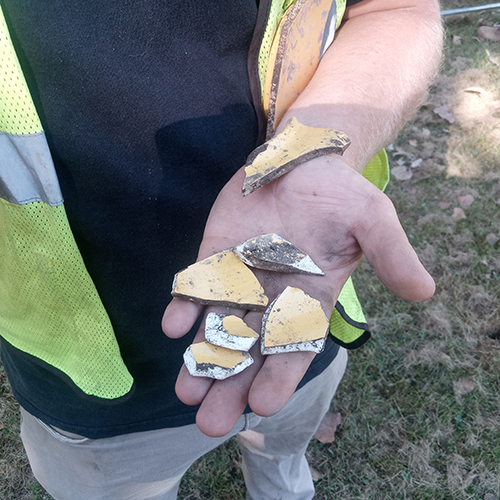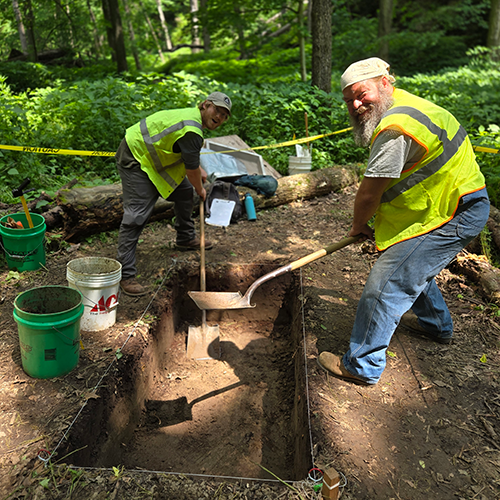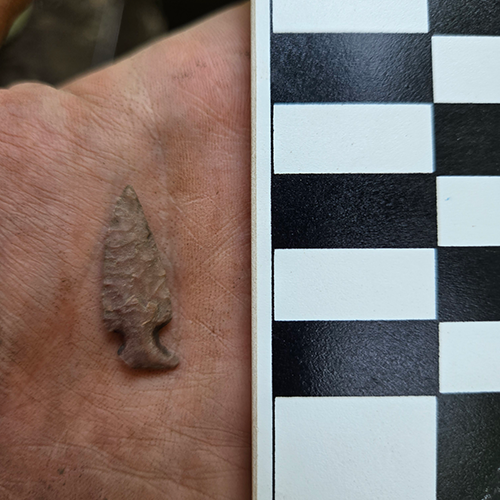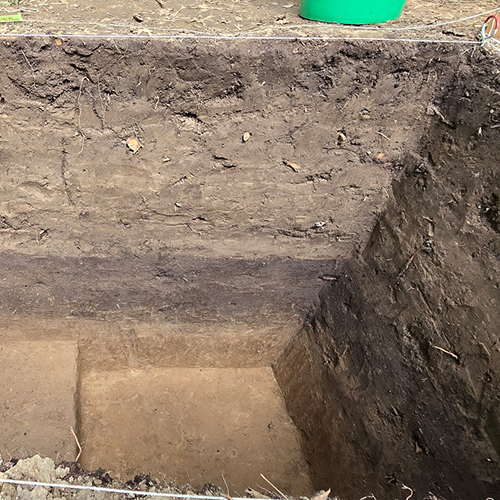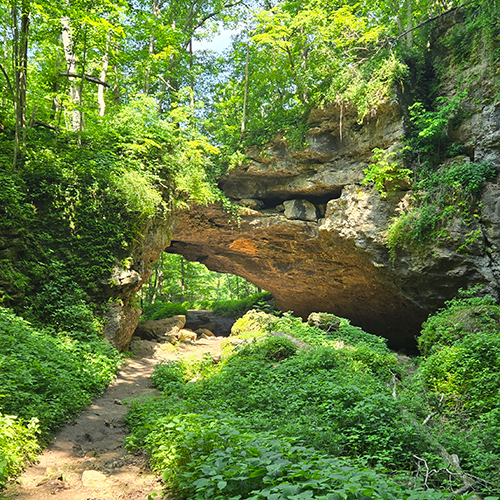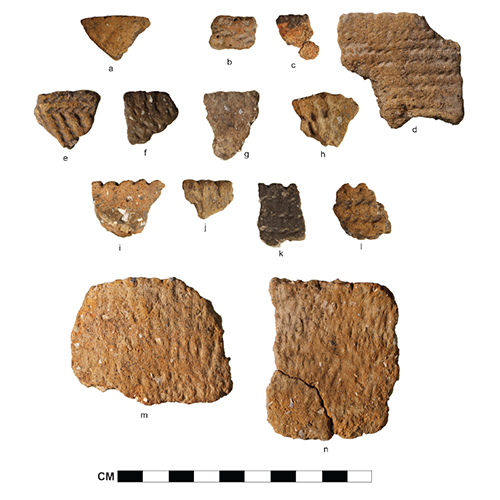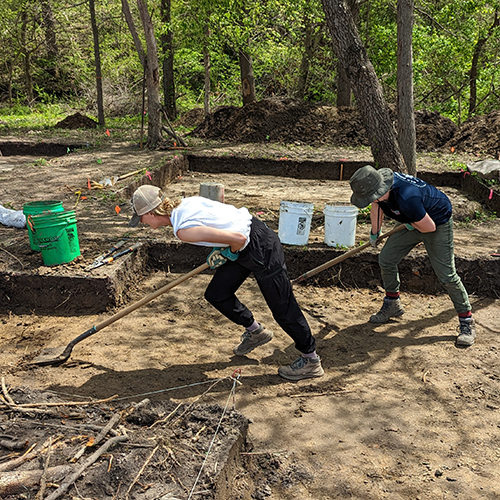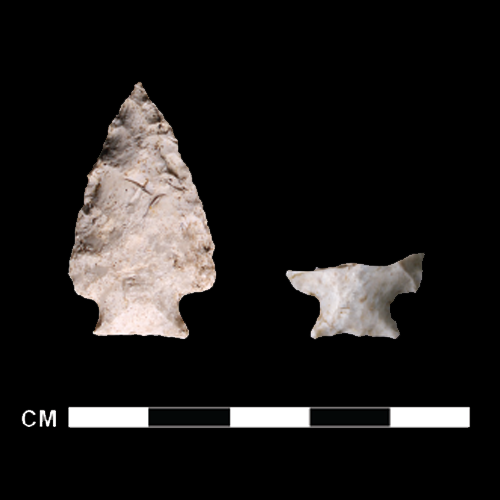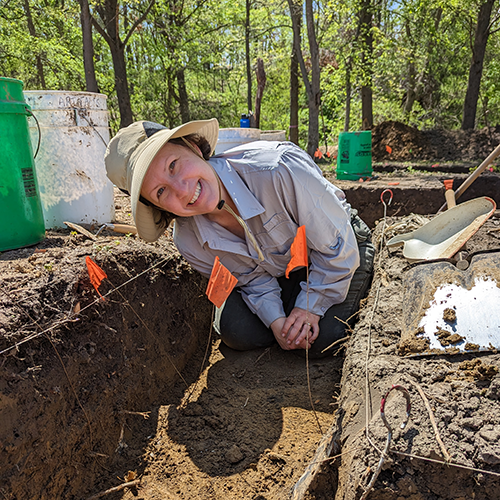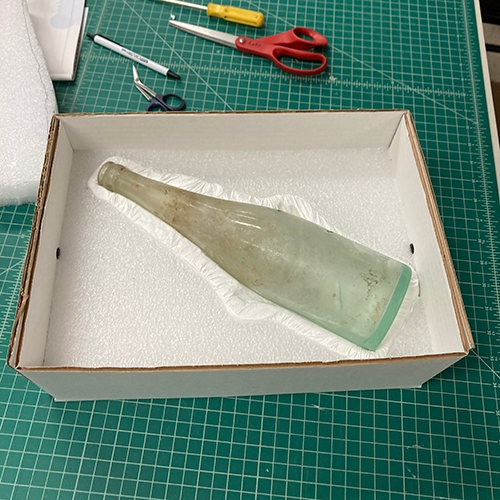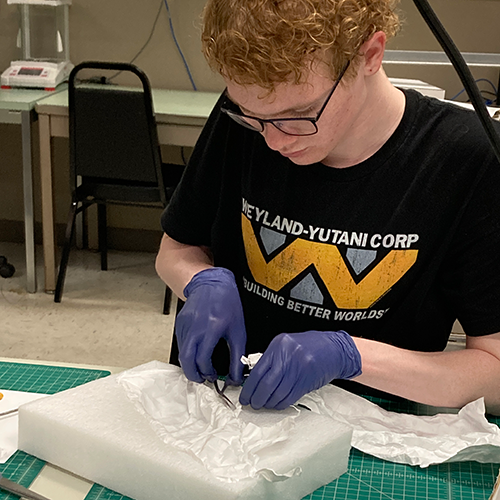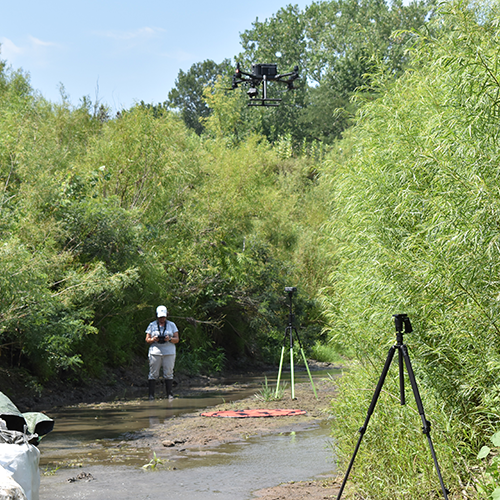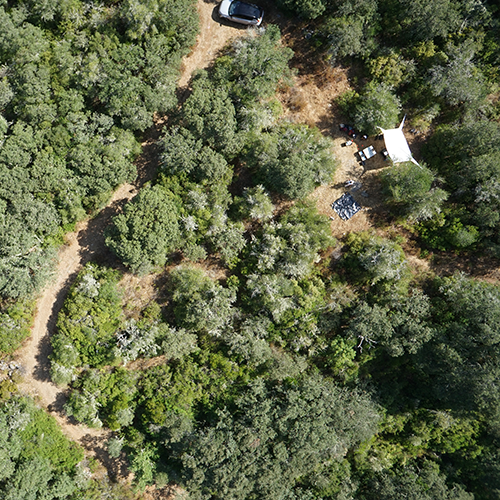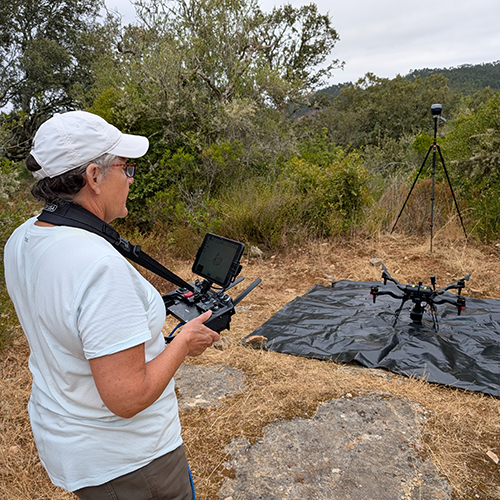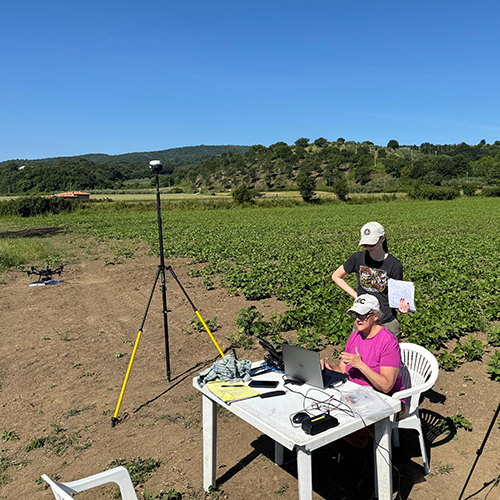
Previous Years
Office of the State Archaeologist annual reports from 2010 through the last fiscal year are archived in the University of Iowa Digital Library. They are viewable in PDF format.
FY2025 OSA Annual Report
WHO WE ARE
ACADEMIC ACTIVITIES
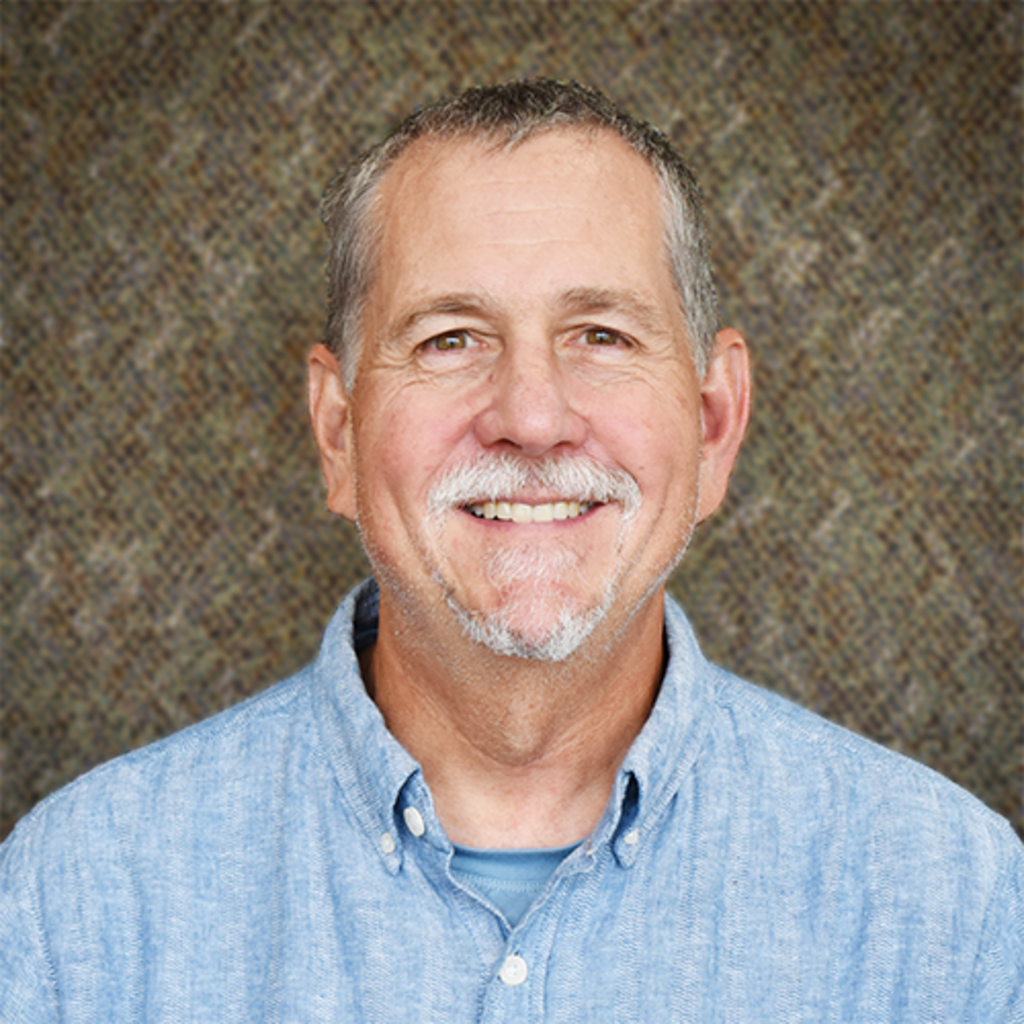
John Doershuk | State Archaeologist | Instructor
Field Archaeology at Iowa Lakeside Laboratory
The 2025 Lakeside Laboratory archaeological field school included students from UI, UNI, and the University of Dubuque who continued investigation of a portion of 13DK9, the Abbie Gardner Sharp Cabin Historic Site located in Arnold’s Park on the shores of West Okoboji Lake. The students discovered copious artifacts related to Abbie’s late nineteenth-early twentieth century use of the cabin as one of Iowa’s first heritage tourism locations and a possible precontact component that the Lakeside Lab Summer 2026 field school will continue to investigate. [Summer 2025, 9 students]
Anthropology 3240: CRM Archaeology: Practice and Practicalities
Cultural Resource Management (CRM) archaeology is the largest sector of archaeological research in the United States in terms of employment, funding, and field- and lab-related activity. CRM archaeologists are part of broad sustainability initiatives which include preserving and investigating information about the past while assisting their clients in navigating the complexities of compliance requirements emanating from federal, state—and increasingly, local—laws and regulations concerning historic preservation and environmental compliance. CRM archaeology projects frequently include a social justice component involving control of the past and the voice modern Native Americans and other descendant communities have concerning treatment of ancestral material legacies. [Fall 2024, 20 students]

First-Year Seminar: The Skills That Time Forgot: An Introduction to Experimental Archaeology
Veronica Mraz | Project Archaeologist | Instructor
Students explored how people made arrowheads and early ceramics through a fun, engaging, hands on class. This course explored the process of combining the scientific method with archaeological artifacts and using the results from these experiments to learn about the people that created the artifacts recovered from archaeological sites. [Fall 2024, 17 students]
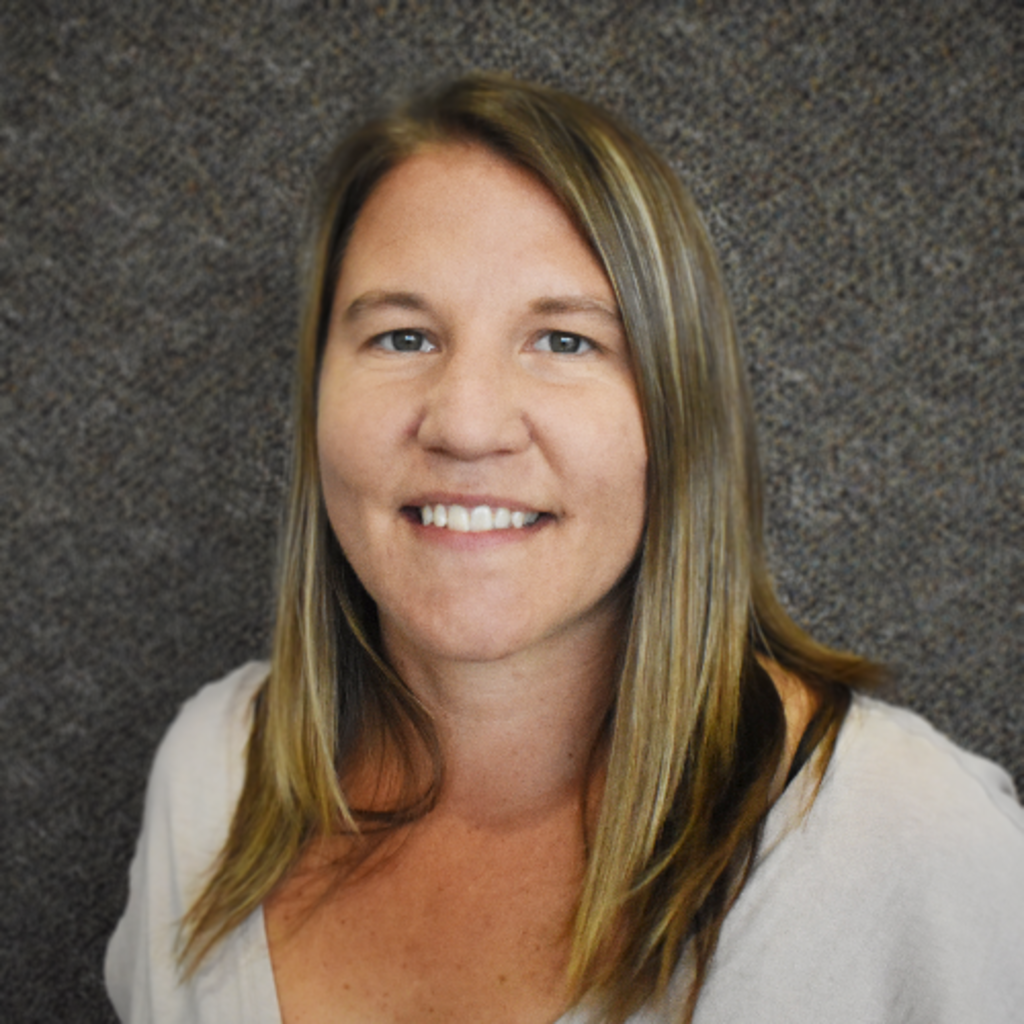
Anthropology 3305: Human Osteology
Lara Noldner | Bioarchaeology Director | Instructor
Students build knowledge of the human skeletal system that is foundational to a diversity of other fields in anthropology and medicine including: forensic anthropology, paleoanthropology, bioarchaeology, medical anatomy, physical therapy, human biomechanics, and biomechanical engineering. Topics include bone microstructure, growth, and remodeling; basic anatomy and nomenclature pertaining to the whole human skeletal system; methods for assessing age, sex, stature, ancestry, pathologies and cultural modification; applications of basic principles and data sources in anthropological research; and ethical considerations for human skeletal collections and pertinent federal and state statutes. [Fall 2024, 8 students]
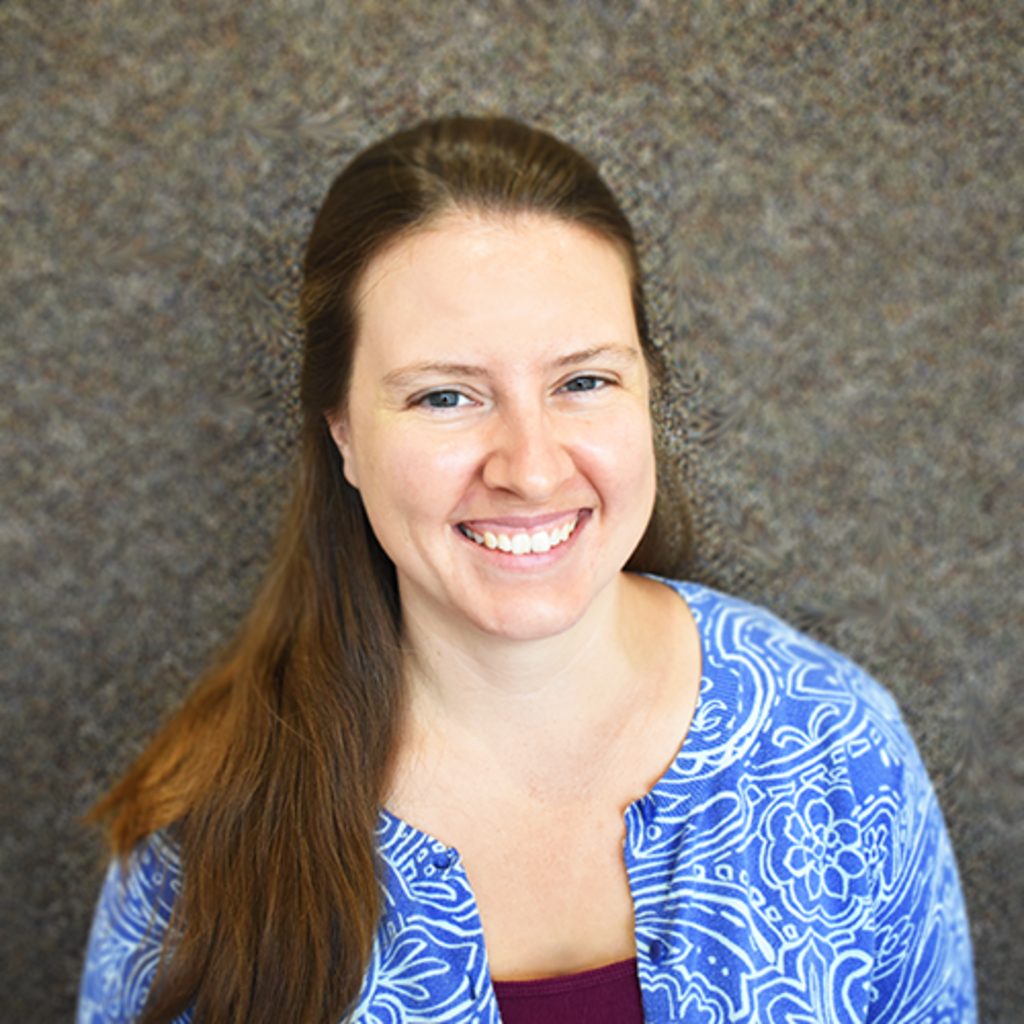
Anthropology 3145: Excavation to Exhibit: Making Artifacts Public
Carrie Parris | Collections Director | Instructor
How do museum professionals decide what to put on display? How are ethical issues involving cultural sensitivity and potential appropriation handled? What is involved in developing the theme or story of an exhibition and what are best communication practices to enhance public engagement? Who participates in the research and decision-making? It could be you! In this unique hands-on learning experience, you will work with fellow students along-side professional staff from the UI Office of the State Archaeologist (OSA) and the UI Stanley Museum of Art to develop your knowledge, skills and abilities in the practical aspects of exhibition design, including object selection, research, condition assessment, and interpretation. Your semester will culminate with being part of the installation team for a Stanley Museum exhibition featuring historically significant but publicly little known archaeological artifacts selected from the State Archaeological Repository. [Spring 2025, 15 students]
OFFICE & STAFF ACHIEVEMENTS
FY2025 Staff Transitions
OSA welcomed two new Research Archaeologists in FY2025. Alexandra (Alex) McFarland started on March 31. She completed her undergraduate and master’s degrees at Youngstown State University in Ohio. Before joining OSA, Alex's academic and contract archaeological work took her to the Bahamas, Sicily, Hawaii, Guam, and Palau, as well as across the Great Plains, the deep south, and New York.
Michael (Mike) Betsinger started on May 27. Mike received his undergraduate degree in Anthropology from the Minnesota State University of Moorhead, then completed his graduate work at the University of Maryland, College Park. Before coming to the OSA, he worked in Minnesota, Maryland, Virginia, and Washington, D.C. In addition to his archaeological fieldwork experience, he has a background in cemetery preservation, public archaeology, and teaching. His recent research examines the relationship between liquor businesses known as saloons and transient laborers in Fargo, ND, and Moorhead, MN, during the late nineteenth and early twentieth centuries.
Professional Development and Service
OSA staff continually strive to learn new skills, participate in regional and national conferences, and contribute to the profession through service.
A number of staff members participated in Society for American Archaeology and American Cultural Resources Association webinars, including:
- ACRA Webinar: Election 2024: What is Means for CRM
- SAA Collections Careers Webinar
- SAA Webinar: Indigenous Archaeology in Practice
- SAA Webinar: A Practical for Prioritizing Archaeological Collections
- SAA Webinar: Introduction to Sedimentology
OSA continued its involvement with the Alexandria Archive Institute’s FAIR+CARE Network grant, with State Archaeologist John Doershuk participating in early October 2024 in a three-day workshop culminating Year 1 of the three-year grant. The workshop, hosted by the primary grant recipients, was held at the at the Lodge at Marconi in Marshall, CA (in the San Francisco Bay Area). The end-of-Year-2 workshop will be held at the same location in October 2025 and Carrie Parris will be the OSA’s representative.
Carrie Parris completed the University of Iowa’s Practical Applications of Supervisory Skills (PASS). PASS is a six-week comprehensive training series designed to support supervisors. Carrie also attended a 3-day workshop on the Care of Metals hosted by the Center for Collections Care at Beloit College and completed several training webinars including:
- Texas Historical Commission Webinar: From Clear to Compelling: Writing Label Copy that Moves Visitors
- Gaylord Archival Webinar: Pitfalls to Avoid in Exhibit Planning
- ICA Webinar: Understanding and Caring for Plastics in Collections
Seraphina Carey, Maizy Fugate, and Carrie Parris attended the Save Our Stuff Conference hosted by the Iowa Conservation and Preservation Consortium in Ames, IA.
In response to UI’s move towards greater accessibility and new accessibility requirements for digital documents, Elizabeth Reetz, Carrie Parris, and Cindy Peterson attended webinars on creating accessible documents, hosted by Accessibility@IOWA.
Elizabeth Reetz attended the National Association for Interpretation (NAI) annual conference in St. Augustine, FL, including a full-day pre-workshop on integrating informal and K-12 education. The conference included a series of short, hands-on workshops focused on building skills in various aspects of interpretation development, delivery, and assessment.
Notable Publications

A Practitioner's Guide to Public Archaeology
Published in September 2024 by Rowan & Littlefield, this comprehensive guide was co-edited by OSA’s Elizabeth Reetz, along with Stephanie T. Sperling, and features contributions 38 archaeologists, educators, museum professionals, archaeological entrepreneurs, and Tribal historic preservation professionals including the OSA Indian Advisory Council’s Suzanne Wanatee Buffalo and Julie Martineau. The book focuses on key components of planning, implementing, and assessing public archaeology programming; presents advice and ideas for various community and classroom program formats; and highlights real-word examples from experts in the field.
Special Projects
Soils and Sites
Bill Whittaker and Ryan Lange collaborated on the third edition of Precontact Archaeological Sites with Intact Deposits in Iowa and their Associated Soil Types, an important research tool utilized by archaeological consultants and agency personnel responsible for historic preservation activities in Iowa to understand the preservation potential of mapped soil types and to understand factors which affect precontact site preservation.
Historic Farmstead Evaluation Tool
Iowa contains some of the most productive farmland in the US, and the state’s history is deeply intertwined with agricultural developments over the past two centuries. Vast numbers of Iowans lived and worked on farms throughout this period. Farmsteads are among the most common archaeological sites found in Iowa, yet evaluating the significance of any individual farmstead can be challenging. This is due to the typically intact features and deposits present at these sites, as well as the tremendous variation in the function and appearance of farmsteads across the two-century timeframe. With support from the Iowa Department of Agriculture and Land Stewardship and Iowa Department of Transportation, OSA staff completed work on Iowa Farmsteads: Historic Contexts and Archaeological Evaluation. This is not only a collection of historic contexts, but it also provides a current “state of the archaeology” so to speak regarding farmstead resources and farmstead research. Further, it includes an evaluation tool, whereby providing users the benefit of taking their data and site information and walking them through a consideration of site evaluation. The tool thus is a starting place for researchers that gives the data provided by individual farmstead sites the primacy, along with project stakeholder input, on establishing eligibility for the National Register of Historic Places.
BLK Mastodon, Wayne County, Iowa
Wayne County is a relatively remote rural county in Iowa ranking 96th of 99 counties in population density but features the vibrant and well-managed Prairie Trails Museum that enjoys strong community support. A 2022 discovery by an area resident of a complete and surprisingly well-preserved mastodon femur in a drainage in the southwest part of the county led to a community-initiated research project that ultimately included the landowners, museum staff, local interested avocationals, and University of Iowa Office of the State Archaeologist (OSA) personnel. Initial project development took the traditional form of requests to OSA to “please come do a dig!” that typical time and especially cost constraints rendered almost impossible to contemplate. As key community leaders came to understand the realities of the logistics and expenses associated with the scientific recovery of an unknown quantity of potentially well-preserved megafauna remains—particularly if approached archaeologically (a condition of OSA involvement)—the tenor of the relationship significantly evolved into a real collaborative enterprise resulting in a two-week field project in August 2024 supervised by John Doershuk with assistance from OSA project Archaeologists Veronica Mraz and Warren Davis. Over 1,000 community volunteer hours were logged during the two-week field session and the cooperation of the landowners was of particular importance to the success of the endeavor. The BLK Mastodon is Iowa’s most complete mastodon skeleton recovered to date with 20 different elements represented, including the almost complete cranium and a portion of one tusk. The remains date to between 13,600 and 13,900 and therefore potential overlap with when the earliest known Native American ancestors first began utilizing what is now known as southern Iowa.
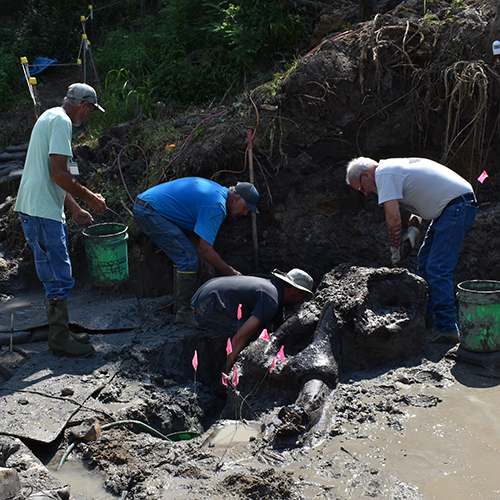
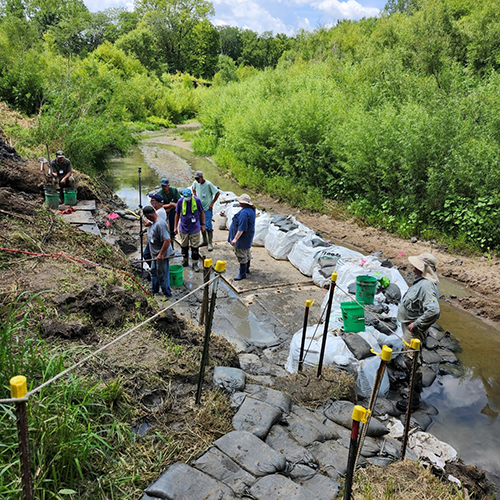
New Perspectives on Glenwood Phase Sites
In October 2024, OSA launched a comprehensive scientific report and educational ArcGIS StoryMap on Glenwood phase archaeology and historical highway excavations on US 34 in Mills County from 1969-1973. This project was funded by a multi-year Statewide Transportation Enhancement Program grant from the Iowa Department of Transportation.
Nearly 40 years after the excavations, the Iowa DOT-funded team, led by Principal Investigators Steve Lensink and Joe Tiffany, compiled and reviewed the surviving US 34 project notes, photographs, and maps and examined more than 83,000 artifacts. The past twelve years of artifact and data analysis from the sites that are now buried under US 34 has revealed unknown facts about the Glenwood phase and deepened our understanding of the innovative fourteenth-century Indigenous farming peoples who lived in the lodges that comprise these sites.
The scientific report, "A Statewide Transportation Enhancement Grant Scientific Report: The Archaeological Excavations Conducted between 1969 and 1973 in Response to the U.S. Route 34 Relocation Project, Mills County, Iowa," is available for free through Google Drive.
Black Hawk Rock
In May 2025, OSA led a limited excavation at the site of “Black Hawk Rock” in Burlington, in partnership with and supported by Russ Fry, City of Burlington, and Des Moines County Historical Society. This site is hypothesized to be an important Tribal meeting area where Black Hawk reportedly held council. Local volunteers assisted with the fieldwork. The excavations yield two pre-contact chert flakes from deeply buried soils. These likely pre-date any known association with Black Hawk in the 1800s but demonstrate the continuity of Native American ancestors in the region. Much of the recovered artifacts proved to be from the late 1800s through mid-1900s, including numerous whole and broken glass bottles.
In the Media
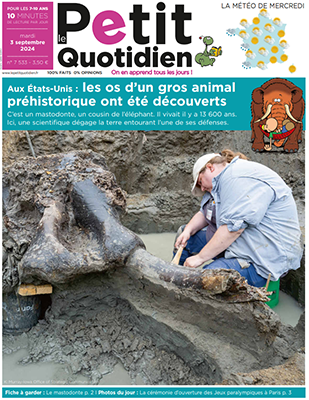
Several media outlets and other organizations featured OSA staff and projects via more than 30 radio interviews and podcasts, newspaper and web articles, television and web news clips, social media shorts, and YouTube videos. News about the Wayne County mastodon finds was heavily circulated, particularly in August 2024, and reached international publications like CNN, BBC, Smithsonian Magazine, npr, and Popular Science.
Expand to see media titles and links
| Date | Title | Outlet and Link |
|---|---|---|
| July 25, 2024 | Learning about Indigenous culture and environmental preservation on Iowa waters | Iowa Public Radio |
| August 15, 2024 | Mastadon [sic] bones recovered from Wayne County site | Radio Iowa |
| August 15, 2024 | Prehistoric find: Mastodon skull unearthed in southern Iowa | KCCI (CBS) |
| August 16, 2024 | 13,600-year-old mastodon skull found in Iowa creek | CBS News |
| August 16, 2024 | Archaeologist discovers 13,600-year-old prehistoric mastodon skull in Iowa | Des Moines Register |
| August 16, 2024 | Archaeologists excavate well-preserved mastodon skull in Iowa | KCRG (ABC) |
| August 16, 2024 | Office of the State Archaeologist: Mastodon skeleton unearthed in Wayne County | We Are Iowa |
| August 16, 2024 | Unearthing mastodon bones in southern Iowa | Iowa Now |
| August 18, 2024 | A 13,600-year-old mastodon skull is unearthed in an Iowa creek | npr |
| August 18, 2024 | On the trail of Iowa history at Mulberry Center Church | Daily Freeman-Journal |
| August 19, 2024 | 13,600-year-old mastodon skull uncovered in Iowa | Smithsonian Magazine |
| August 19, 2024 | Archaeologists find mastodon skull in Iowa, search for evidence it interacted with humans | USA Today |
| August 19, 2024 | Watch archaeologists unearth massive ancient mastodon skull in Iowa | Des Moines Register |
| August 20, 2024 | A beautifully preserved mastodon skeleton has been unearthed In Iowa | IFL Science |
| August 20, 2024 | Huge 13,600-year-old mastodon skull and bones unearthed in Iowa | LiveScience |
| August 21, 2024 | Iowa excavates its first-ever mastodon fossil | artnet |
| August 21, 2024 | Unearthing mastodon bones in southern Iowa | University of Iowa YouTube |
| August 22, 2024 | Ancient mastodon skull discovered in the US | BBC |
| August 23, 2024 | Archaeologists look for human link after unearthing giant fossil | CNN |
| August 23, 2024 | Mastodon skull Wayne County Miller | KCRG (ABC) |
| August 26, 2024 | Huge mastodon skull found in a rural Iowa creek | Popular Science |
| August 30, 2024 | 13,600-year-old mastodon skull discovered in Iowa riverbank | My Modern Met |
| August 30, 2024 | Research begins on 13,600 year old Mastodon remains found in Iowa | KGAN (CBS) |
| September 3, 2024 | Aux États-Unis : les os d’un gros animal préhistorique ont été découverts | Le Petit Quotidien |
| January 11, 2025 | Hawkeyes at home: Make no bones about it | The University of Iowa Center for Advancement YouTube |
| January 27, 2025 | Archaeologist to share details of rare Mastodon discovery in Iowa | WQAD8 (ABC) |
| January 28, 2025 | Iowans band together to unearth and preserve mastodon skull | Iowa Public Radio |
| January 29, 2025 | New details revealed about 13,600-year-old mastodon found in Iowa | The Travel |
| February 13, 2025 | Mastodon skull offers glimpse of Iowa 13,000 years ago | Iowa Public Radio |
| February 18, 2025 | What should you do if you find a cool artifact in the US? | LiveScience |
| February 20, 2025 | 'The Negotiator' documentary tells the little known — but critical — story of Billy Caldwell | Iowa Public Radio |
| February 21, 2025 | Facebook reel on the Wayne County Mastodon | Iowa Public Radio |
| April 15, 2025 | UI praised by tribal leaders for repatriation work and collaboration | The Daily Iowan |
| June 11, 2025 | Living Native histories in 'Warrior Girl Unearthed' | Iowa Public Radio |
BY THE NUMBERS
65
served Iowa and
Midwest region as a
UI research center
$ 1,827,753
support from sponsored
grants and contracts
1 %
and endowments
contributed to the
OSA budget
58
adjunct researchers
worked for OSA
during FY 2024
2,520
hours contributed to
OSA projects
346
newly accessioned
during the fiscal year
32,479
recorded by the end
of the fiscal year
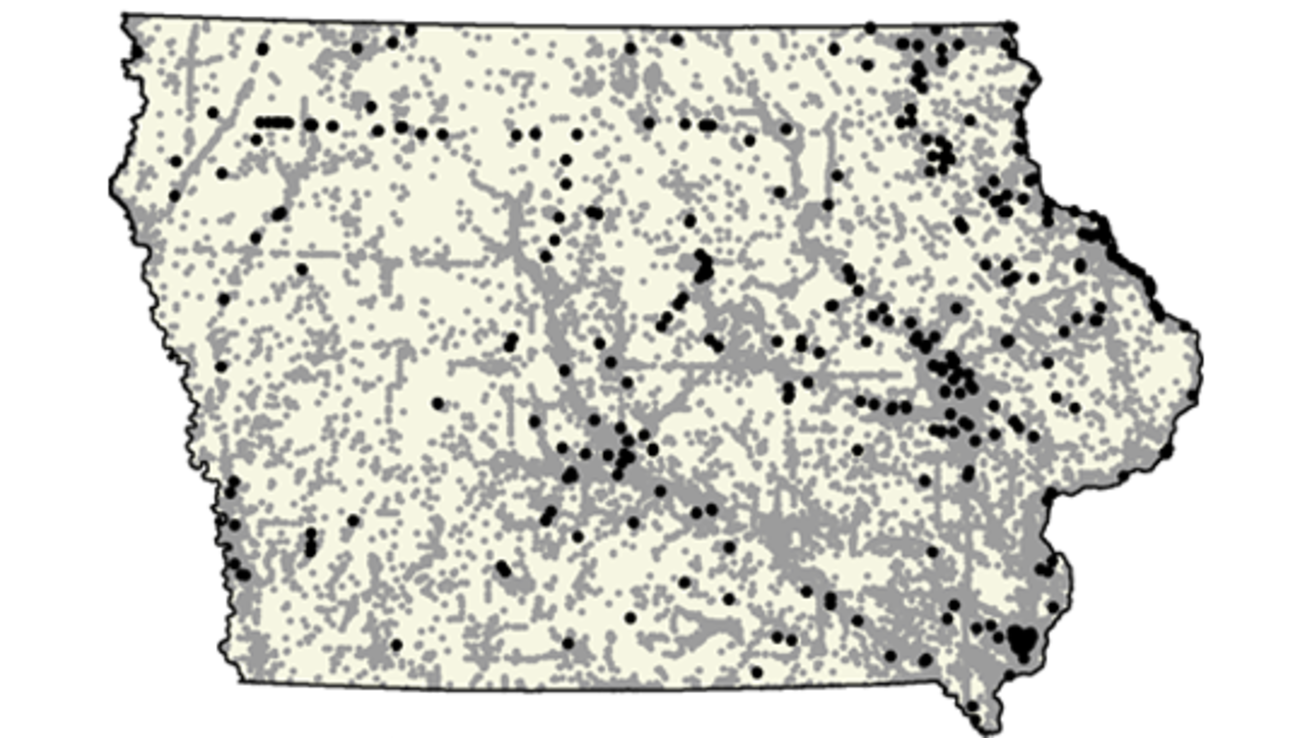
13
58
3,600 +
through OSA
and archaeology
events
22
STUDENT & VOLUNTEER SUCCESS
Many OSA staff members mentor students and train and supervise student workers, interns, and other volunteers. The OSA actively supports undergraduate and graduate student use of its archaeological, osteological, and comparative collections; scholarly documents; electronic databases; scientific instrumentation; and laboratory space for degree-related research.
These resources contribute to the educational experience of students in diverse UI departments including:
Anthropology
Biology
Classics
English
Ethics and Public Policy
History
Museum Studies
Physics and Astronomy
Religious Studies
School of Art, Art History, and Design
School of Earth, Environment, and Sustainability
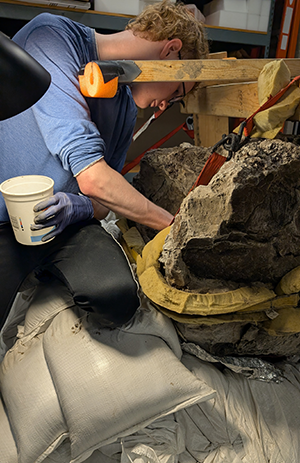
In FY 2025 the OSA facilities, collections, and staff provided classroom enrichment and workplace experience for a total of 22 students and three members of the public who worked to log 2,520 hours at the OSA contributing to project activities.
Participating Institutions:
University of Iowa
Cornell College
Iowa Archeological Society
Kirkwood Community College
Iowa City School District
RESEARCH
ARCHAEOLOGICAL & ARCHITECTURAL INVESTIGATIONS
The OSA conducts both contract and grant-funded research involving archaeological and architectural history studies statewide. These projects, regardless of funding source or sponsor, generate important new knowledge about precontact and historic era Midwestern adaptations, and they form the basis for many staff publications, professional and public presentations, and student and faculty research projects.
Infrastructure Surveys
Excluding Iowa Department of Transportation (Iowa DOT) projects discussed below, the OSA conducted 142 archaeological and architectural projects in FY2025, significantly contributing to the enhancement of statewide economic development. In addition to 23 archaeological or architectural history Phase IA and desktop evaluations, OSA staff conducted 85 Phase I archaeological surveys and one Phase II testing project, recording or supplementing information on 35 archaeological sites. Seven Phase I architectural history surveys were completed, along with seven bridge assessments or evaluations. Other projects included field condition assessments, creation of brochures on cultural resources, and an artifact analysis. The FY2025 efforts included projects in 57 different Iowa counties, serving 23 different sponsors. Local government clients included the cities of Ames, Iowa City, and Marshalltown, and the counties of Iowa and Marion. State agency clients included the Iowa Department of Agriculture and Land Stewardship (IDALS), Iowa Department of Natural Resources, and the State Historical Society of Iowa. Two non-profit affordable housing clients, Cedar Valley Habitat for Humanity and the Hope Community Development Corporation, were provided CRM compliance support.
Iowa Department of Transportation
FY2025 marks 55 years of contracted services with the Iowa DOT for archaeological investigations and 36 years of historic architectural evaluations. A total of 149 Cultural Resource Evaluation reports were submitted. Six Phase I survey reports were completed, along with four other reports dealing with construction monitoring near the Old Coralville Cemetery, mitigation efforts related to road improvements, and a Phase IA architectural reconnaissance survey. In addition, OSA completed a historic farmsteads context and archaeological evaluation tool project for the Iowa DOT and IDALS.
Project Highlight: Architectural History at the US EB 30 Bridge Replacement
The OSA conducted a historic architectural mitigation related to replacement of the US 30 eastbound Cedar River bridge just south of Cedar Rapids, Linn County. Built in 1953, this structure was the earliest remaining example of its type––a steel continuous welded I-girder bridge with floorbeams and two girders. The project created three products: a technical report, summarizing the bridge’s historic importance; a lecture about the bridge; and a StoryMap, discussing its significance in a public-friendly fashion. This StoryMap is now hosted on the Iowa DOT website, and the videos are available as a YouTube playlist.
Project Highlight: Phase II Archaeological Study of 13JK48, Maquoketa Caves State Park
In June 2025, OSA tested precontact site 13JK48 on behalf of the Iowa Department of Natural Resources prior to planned bridge replacements in Maquoketa Caves State Park. Site work in 1980 recovered a small number of artifacts including lithic debitage and Late Woodland pottery. Based upon the previous investigation, the site was originally assumed to be ephemeral with low concentrations of artifacts and a low potential to answer important future research.
OSA relocated the site in the summer of 2025. Over 700 artifacts were recovered from Phase II testing, an unexpectedly high quantity compared to the prior work. Artifacts included several bifaces, a possible graver, a cord-marked pottery sherd, and a Scallorn projectile point, establishing a Late Woodland age of occupation for the site. A side notched projectile point fragment was also found at one test unit’s lower levels, suggesting a possible Archaic component. Almost all artifacts were found on a buried terrace landform protected by historic age colluvium and alluvial overbank wash.
As a result of this Phase II study of 13JK48, OSA recommended the site eligible for listing in the National Register of Historic Places under Criterion D, as the site is both significant and retains a high level of integrity. The site is a pristine example of a smaller seasonal occupation. Because of this archaeological work, 13JK48’s significance and preservation can be factored into future park improvement plans.
Project Highlight: US 61 Road Improvements: Late Archaic and Late Woodland Data Recovery Excavations
Ahead of road improvements along US 61 in Louisa County, north of Burlington, two single-occupation precontact temporary base camp sites underwent large-scale excavation. At early Late Archaic site 13LA921, over 7,400 artifacts were recovered. Analyses demonstrate a range of activities occurred there, including fire building; gathering and processing of nuts, seeds, and probably, meat; lithic manufacture and tool hafting; and scraping and whittling. Radiocarbon dating places these activities between about 4408 to 4186 calBP.
Late Woodland (Louisa phase) site 13LA904’s radiocarbon dates place its occupation around cal AD 1020. Excavations recovered over 12,000 artifacts, including Koster projectile points, Burris ware ceramics, sherd disks, and a flat-lipped and squared peaked elbow pipe. The eight identified features consisted of a shallow basined, 4 x 6 m keyhole house with associated interior and exterior features (three hearths, a hearth cleaning dump, three lithic processing areas). Analysis of thermally altered clay suggests the presence of a disarticulated packed earth (clay) house floor—the first such identification from a Late Woodland site in Iowa. The limited botanical specimens are from plants available during the fall through early winter: carbonized nutshell, maize, and possible squash or gourd rind.
RESEARCH COLLECTIONS
The OSA continually adds archaeological materials and related documents to the State Archaeological Repository and provides materials for local, regional, and national exhibition and research purposes.
118
for research or exhibits

9
this fiscal year
37
2,200 +
306,091
94 %
Loans
Nine loans of archaeological material were made during FY2025.
Individuals borrowing OSA materials include researchers from the Office of the State Archaeologist, the University of Iowa Stanley Museum of Art, Webster County Conservation’s River’s Edge Discovery Center, Iowa State University, Augustana University, and Penn State University.
Artifacts from 24 accessioned collections and three unaccessioned collections representing material from 24 sites and one notable location were loaned during FY25.
Artifacts were loaned for research, analysis, informal displays accompanying presentations, and exhibition.
Collections
The archaeological collections at the OSA are used for many different purposes including outreach and educational, loans, and research. In FY2025, 118 individual accessions, representing 89 unique sites, were accessed. The majority of these collections were accessed for research purposes, as examples for groups visiting the OSA, or for consideration for exhibit.
Users of collections during FY2025 included 37 individuals with a range of affiliations such as the OSA, University of Iowa Department of Anthropology, Cornell College, Augustana University, the Sanford Museum and Planetarium, and the State Historical Society of Iowa.
Rehousing Project
Many intern and volunteer hours during FY2025 were dedicated to the Rehousing Project. This project focuses on updating the storage materials used in the repository. Interns and volunteers systematically replace old, non-archival bags, boxes, tags and labels with new archival quality bags, boxes, and printed paper tags. During FY2025, 627 accessions were rehoused.
In June of FY2025, Research Collections Director Carrie Parris taught a short workshop on building cavity mounts. A cavity mount is a custom shape cut into a plank of foam and lined with soft, archival-quality materials that provide support for an object. Cavity mounts are common storage solution for large, uniquely shaped, or delicate artifacts.
Archives
OSA’s archives team, led by Maizy Fugate, added 5,984 new records to iArc, including reports, books, conference papers, manuscripts, journal articles, newspaper articles, and photographs. iArc continued to be important to research at OSA and outside agencies, firms, and individuals.
iArc Stats for FY2025:
306,091 total records, 94% available digitally on iArc
3,881 legacy documents were accessed 2,437 times
1,401 reports submitted to Iowa DOT were accessed 2,061 times
1,473 reports submitted to Iowa DNR were accessed 1,595 times
External iArc users accessed 7,554 documents a total of 14,346 times
RESEARCH TECHNOLOGY
32,479
448
167
683
OSA’s commitment to conducting and disseminating modern high-quality archaeological research requires a significant investment in research technology. From maintaining complex databases, to deploying a suite of scientific instruments and equipment, to supporting an array of Internet and other social media, the OSA’s involvement in research technology covers the gamut of twenty-first century breakthroughs in archaeology.
Iowa Site File
Most archaeological sites are recorded in the Iowa Site File as a result of cultural resource surveys conducted by professional archaeologists. Some, however, are reported by landowners, avocational archaeologists, and other non-professionals.
Field and Laboratory Technology
Many of OSA’s research endeavors require the use of highly specialized scientific technology in both the field and laboratory setting, including robotic laser transit with data recorder, high resolution GPS units, tablets for mobile data collection, and small drones (UAS) to fly over archaeological sites to create surface models and for infrared thermographic analysis. In FY2025, OSA Research Technology Director Mary De La Garza and Professor Susan Meerdink (UI Department of Geographical and Sustainability Sciences) continued their partnership that includes both technology sharing and instruction by De La Garza, who participated in UI’s Edge of Space program.
De La Garza gathered data for several international projects in addition to work in Iowa, Wisconsin, and Minnesota. The international projects included lidar survey of a known Etruscan site outside of Gradoli, Italy, and an international collaboration focused on the hilltop settlement site of Agroal in Portugal in order to obtain thermal and lidar survey of invisible architectural components from both the early Bronze age and Medieval period.
Website and App Development
During FY2025, the OSA maintained and supported portals for the Iowa Archeological Society, Association of Iowa Archaeologists, Iowa Archaeology (publications), and Ancient Trails in Iowa, as well as support for I-SitesPro, I-SitesPro GIS, I-Sites Public, I-SitesGov, and iArc.
BIOARCHAEOLOGY
45
in FY2025
29
investigations/reports
39
development projects
21
investigations
NAGPRA Work
This year the Bioarchaeology Program published eight Notices of Inventory Completion – one for ancestors originally interred in the Midwest region, one for ancestors with no/limited associated provenience information, one for a necklace belonging to lineal descendants of Inyangami, and five for ancestors originally interred in North Dakota, Arizona (2 separate Notices), Washington, and Wyoming.
Reburial of 73 ancestors and 53 items from Iowa was facilitated, and plans for reburial set for ancestors claimed by the Three Affiliated Tribes (reburial occurred in Late July 2025). Consultation regarding the OSA’s Notice of Proposed Reinterment for ancestors with no associated provenience and the OSA’s agreement with tribes for reburial of ancestors from Iowa was initiated and is ongoing.
Lara Noldner attended the 24th Annual National Association of Tribal Historic Preservation Officers Conference and Sacred Spaces Summit in August 2024, the American Association of Biological Anthropologists conference in March 2025, and the Society for American Archaeology in April 2025.
Other Projects
The Bioarchaeology Program carried out its usual work with landowners who serve as site stewards, and local, state, and federal agencies in upholding our responsibilities for ancient burial site and inadvertent discovery investigations and reporting, and the protection of sites potentially impacted by development.
Sam Murphy also began consultation with Tribal partners to do a large-scale survey for determination of a cultural district that includes the Turkey River Mounds and several other mound sites on surrounding bluffs in Clayton County as mitigation for powerline work that has impacted several sacred landscapes.
Teaching
Lara Noldner taught Human Osteology (ANTH 3305) with 8 students (all undergraduate) completing the course and a First Year Seminar (A Tour of Biological Anthropology) (URES:1000) with 18 students completing the course. She also mentored four students through one Museum Studies internship, two Independent Studies (ANTH:3015), and one volunteer appointment that involved documentation of the University of Iowa Stanford Collection.
STRATEGIC INITIATIVES
The Number of Individuals Reached through Public and Professional Outreach
3,477
1,500
221
503
256
1,167
The OSA provides resources and opportunities that encourage the understanding, appreciation, and stewardship of Iowa’s archaeological past. OSA staff reached over 3,600 people at public, private, and K-12 events; higher education guest lectures, and professional conferences, including interacting with over 120 people live via Zoom. Additionally, OSA reached thousands more through TV and radio interviews.
Exploring Iowa Archaeology in K-12 Education
A total of 503 K–12 students participated in in-person and virtual archaeology presentations and interviews, activities, and tours with OSA staff. Requests for classroom programming came from teachers, after-school groups, homeschool groups, STEM organizations, and robotics teams participating in the 2025 international archaeology-themed challenge.
Additionally, OSA reached over 550 students through rentals of the Iowa Archaeology Discovery Trunks by teachers and nonformal educators.
Bringing Archaeology to Iowa Communities

The OSA continues to foster strong relationships with conservation and heritage preservation organizations across the state. OSA participated in its 9th Project AWARE, which involved 269 participants who paddled 60 miles on the Skunk River in Washington, Jefferson, and Henry counties. OSA participated as “resident archaeologists” and assisted with educational programs at the event, including organizing the participation of Ho-Chunk Nation Tribal Historic Preservation Office, Bill Quackenbush, who brought his hand-made dugout canoe. Paddlers got to experience riding in the canoe with Bill and attended his public presentation.
Outreach activities in partnership with the History and Culture tent at the Meskwaki Powwow recommenced this year, and OSA again delighted to partner with Johnathan and Suzanne Buffalo. Other events for in-person outreach by OSA staff were the Iowa Archeological Society (IAS) fall and spring meetings at Lacey-Keosauqua; Central and Quad Cities IAS chapter meetings; school field trip and public presentations for multiple county conservation boards and public libraries; and other community gatherings across the state.
Special Projects
Strategic Initiatives (SI) staff led and partnered on several interpretive and educational projects in FY2025.
- After attending that National Association of Interpretation’s (NAI) Process of Interpretive Planning workshop in March 2024 and the NAI annual conference December 2024, Strategic Initiatives Director, Elizabeth Reetz, completed a comprehensive interpretive plan for OSA’s education and outreach program and applied to become a Certified Interpretive Planner.
- SI staff had major roles in the development of the Highway 34 ArcGIS StoryMap and the video series for the US 30 bridge project.
- As part of an ongoing partnership with the Sioux City Railroad Museum, Reetz wrote grade school reading level captions for a coloring book that documents OSA’s archaeological work at a railroad worker labor camp.
- Reetz launched her first publication as lead editor and author in September, The Practitioner’s Guide to Public Archaeology: Intentional Programming for Effective Outreach, also led the production of three book chapter and journal submissions for regional, national, and international publications.
- Cherie Haury-Artz, education assistant, led the development of an educational booklet on the Little Sioux River Water Trail with multiple Iowa contributors, to be published in FY2026.
- Reetz and Haury-Artz also completed data analysis for a needs assessment regarding the revision of the Iowa Archaeological Certification Program, and the results were presented at the Society for American Archaeology annual meeting in Denver in April.
In preparation for the archaeology-themed international robotics competition for 2025-2026, SI created a resource page for robotics teams on the OSA website and coordinated messaging and strategy with over 50 archaeology educators across the country.
@IOWAARCHAEOLOGY
The education and outreach content on the OSA website remained a vigorous, interactive conduit between the public and the OSA. The OSA’s social media pages were an important venue for disseminating news and program information in FY2025. Active social media platforms administered by the OSA include Facebook, Instagram, YouTube, and Bluesky. The Facebook page alone was visited over 18,000 times and posts reached nearly 400,000 people.

8,711 followers, up 2,341

14.4k unique views,
145 new subscribers

1,570 followers

321 followers
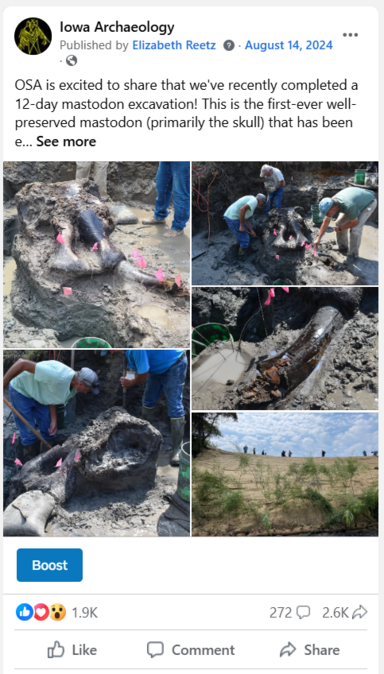
The most popular social media post summarized the 12-day mastodon excavation in Wayne County; it reached 372,049 people on Facebook and was shared over 2,600 times, demonstrating the platform’s powerful potential in terms of engagement and outreach. On YouTube, people watched Iowa Archaeology videos 14,384 times during FY2025.
